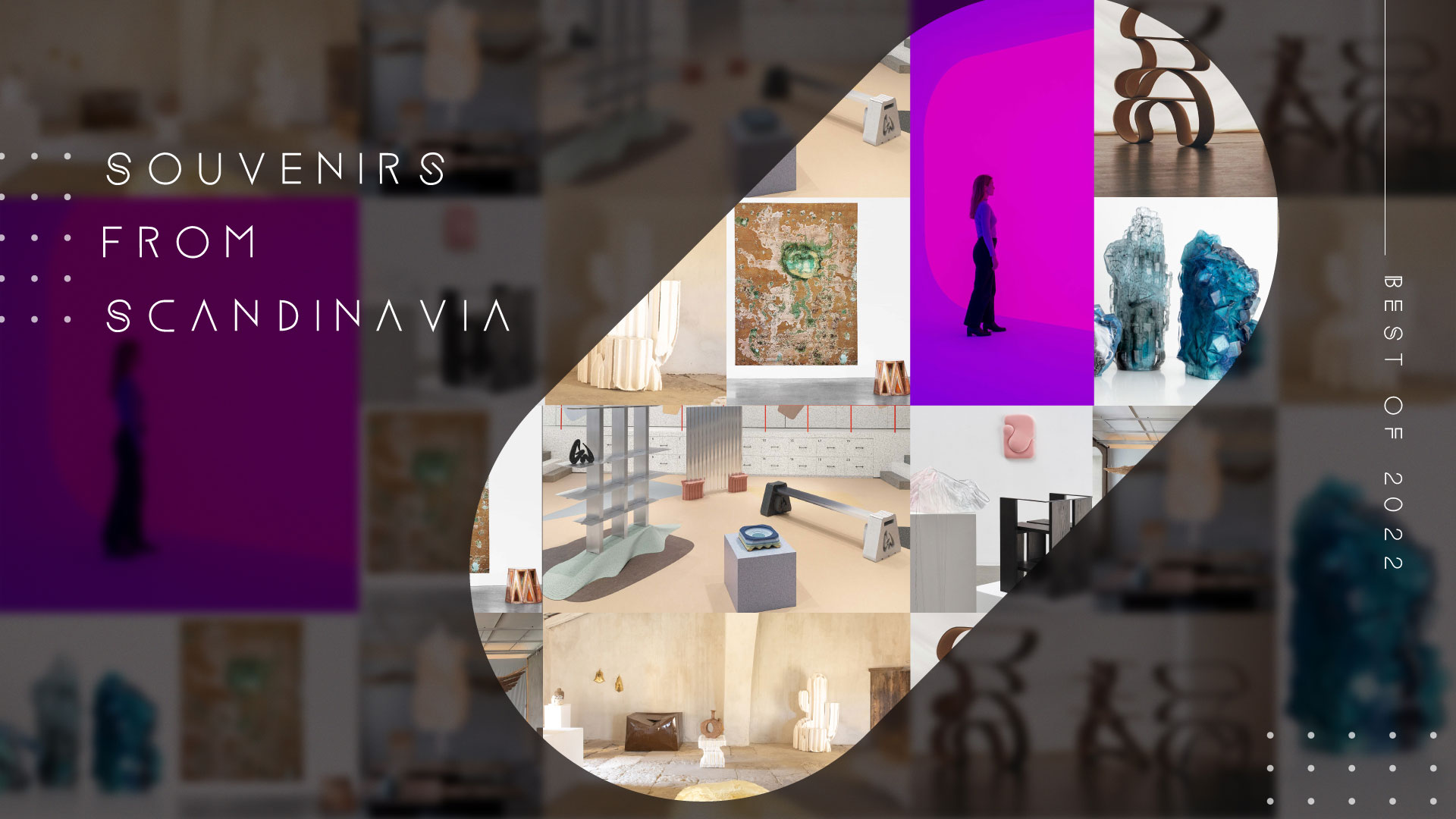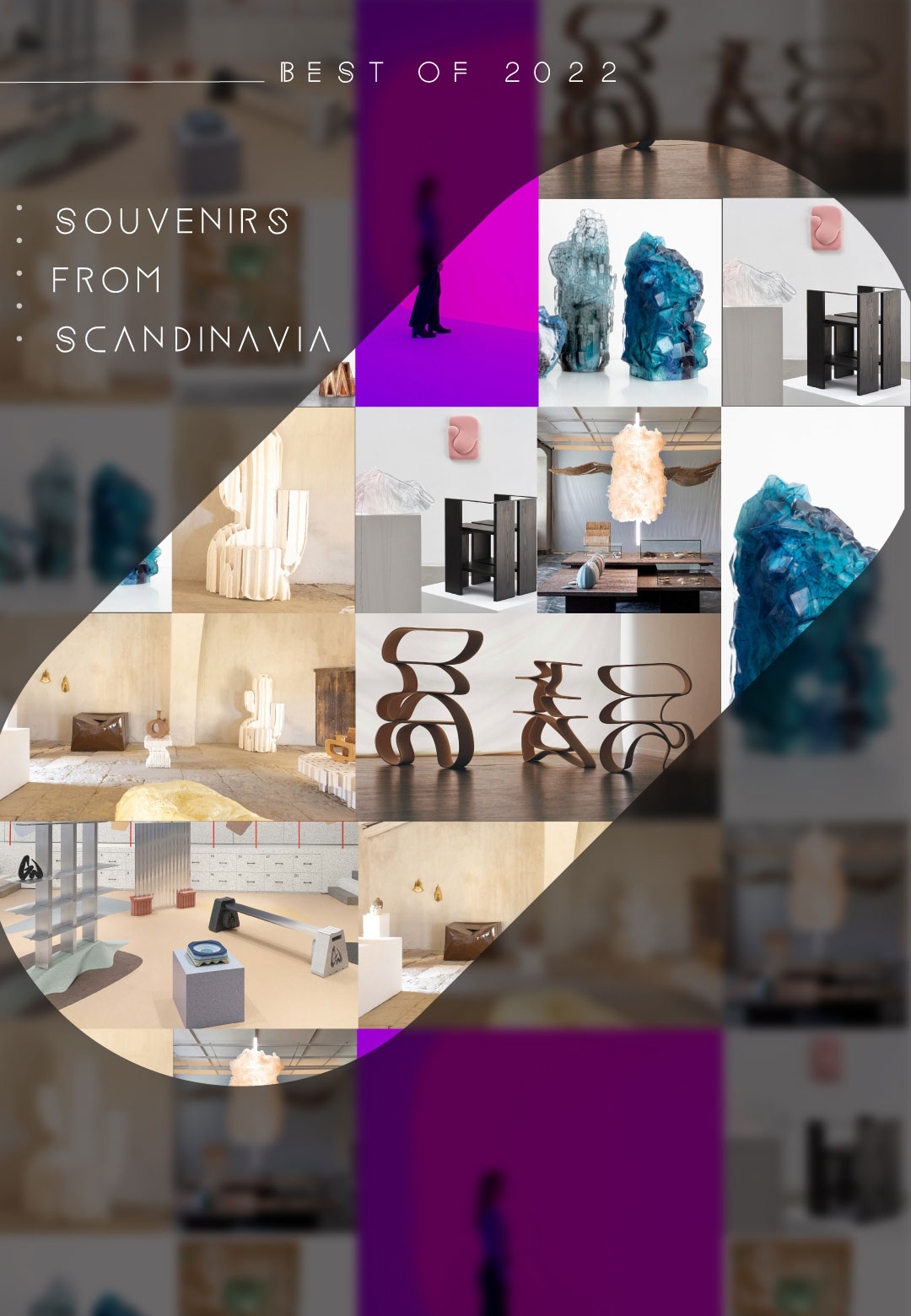Subtlety and calmness best define the dominant aesthetic in Scandinavia. Across the disciplines of interior design, product design, furniture design, art, and architecture, muted hues, delicate lines and curves, and a lack of clutter are the defining features. A lack of pop and colour in Scandinavian design is balanced by innovative and visceral inspirations that guide the mechanisms of these creations.
Trailing experiments in material, technology, and future projections, STIR enlists the Best of 2022 from Sweden, Norway, and Denmark.
Cross-Section by Gustav Winsth
Swedish designer Gustav Winsth’s Cross-Section is a collection of furniture made using vinyl rolls and tiles by floor expert Tarkett. While vinyl rolls are an atypical material for building objects and furniture, the Stockholm-based designer manages to design an array of creations that fulfil utilitarian roles while also helping explore the scope of vinyl as a material. Winsth created the three-dimensional form of the shelf, stool and table in the collection by stacking two millimetres thick vinyl layers on top of one another. In doing so, he manages to create an organic form from a material that is typically used on flat surfaces. Each vinyl layer used to build the furniture items can be dismantled and re-used, thus ensuring reduced waste.
Granland by Simon Mattisson
Picking up spruce wood damaged by the bark beetle, Simon Mattisson from Sweden developed a composite that can be used to sculpt usable objects. The shelves and benches that make up his Granland collection are named after the spruce trees in Sweden that are categorically hunted by the beetles and are now under threat. The form in which the furniture has been sculpted is inspired by the patterns left by beetles on the barks of these trees. In seeking inspiration from the damage done by the bark beetles and using the wood damaged by them, Mattisson manages to communicate the ongoing problem of global warming, of which the increase in the number of the beetles—who become active only during the warm season—is a direct consequence. The increase in the population of beetles has managed to ravage several European forests. While there are no cohesive methods to contain and control their infestation, yet, Mattisson’s attempts to build objects using the damaged wood help make use of entities that are otherwise categorised as unworthy of usage.
Andy Warhol-inspired rugs by Calle Henzel
Handmade art carpets created by Sweden-based painter and collage artist Calle Henzel’s eponymous design studio were recently unveiled in association with The Andy Warhol Foundation of Visual Arts. These carpets, adapted from Andy Warhol's oxidation paintings from 1978, are the product of a two-year process of testing and development that helped translate the paintings to rugs while ensuring identical oxidation outcomes and equivalent textures.
Warhol’s original oxidation paintings, while remarkable, are also contentious. Warhol instructed his staff and guests to urinate on the copper-painted canvases that he had placed on the floor. The acid in urine oxidised the wet copper paint, giving it a shimmering appearance. Warhol explored variously formed stains, shimmering surfaces, and colour shifts in his oxidation paintings. Both in terms of the method used to manufacture them and in terms of style, they represented a departure from Warhol's earlier work. While the majority of the artist's works are classified as Pop Art, his oxidation paintings have an Abstract Expressionism feel to them.
The Warhol x Henzel rugs serve as a tribute to Warhol's artistic efforts. They are crafted by hand from wool and silk. The unusual colour scheme combined with the shimmering effect results in a distinctive piece of artwork that can be used as house decor.
Sculptural furniture by Nebil Zaman
Nebil Zaman, who hails from Iraq and lives in Oslo, Norway, is a product designer who experiments with materials and motifs to make sense of the duality of his existence. His latest experiments led to the creation of a series of objects that mimic the ethereal forms associated with archaeological objects and spaces. His experience in the fields of art, architecture, and technology informs his understanding of different materials, visual languages, visual cultures, forms and functions, as well as production techniques. The white totemic objects, assembled from laser-cut and plaster-cast MDF boards, are characterised by a unique corrugated texture that evokes visions of caves and other naturally occurring entities. While the finely cut MDF boards reflect an element of control in his work, the plaster, roughly covering the individual pieces, gives space to freely mould the pieces, in tandem with the designer’s mood.
Light and Space at Contemporary Cluster
Copenhagen Cluster, a Denmark-based gallery, hosted the lighting exhibition Light & Space earlier this year. Large-scale installations that doubled as luminaires dotted the expanse of the welding factory-turned-exhibition space in Copenhagen. The showcases, spread over an area of 5,000 square metres, comprised work by both renowned and well-known creatives from yesteryear as well as by contemporary artists. The gallery presented works by modern artists such as Anish Kapoor, Olafur Eliasson, and Jeppe Hein alongside creations by well-known American artists such as James Turrell, Doug Wheeler, Robert Irwin, and Bruce Nauman. In the expansive exhibition space, spread across five halls, Robert Irwin’s 16-meter-wide and eight-meter-tall installation, lit by 115 fluorescent tubes commanded a domineering presence. A light-absorbing void by Anish Kapoor, Connie Zehr’s desert landscape, and James Turrell’s iridescent presentation are some of the other works that were displayed at the gallery and that bore references to the American light and installation art movement that was popular in the USA during the 1960s.
Future is Present at Design Museum Denmark
Design Museum Denmark’s The Future is Present, an art exhibition, presented, through an array of abstrusely configured creations, the evolving aesthetics that define contemporary design and art. Dotted with totemic creations that can enrapture and intrigue, the exhibition managed to jerk the visitor's eye open to the fast-evolving dynamics of the creative industry. Encapsulating the contributions offered by both designers and craftspeople, while also showcasing how creatives deal with the impending future, the exhibition was centred on three key themes: people, society, and the environment. Experiments in materials such as textiles, glass, and other salvaged entities metaphorical the abstract ideas of reflecting and introspecting, while also presenting usages of biomaterials and by-products such as the uncanny cow’s intestines, mushroom mycelia, and hemp fibres. The unnerving visuals from the exhibition are an attempt at shining a light and opening a window into the future that awaits us.
Matter at Hand at Hostler Burrows
Centered around material experiments that pivot the process of creation by Danish artists, Matter at Hand, exhibited at Denmark-based gallery Hostler Burrows, showcased the works created by ten artists—Stine Bidstrup, Anne Brandhøj, Yuki Ferdinandsen, Bjørn Friborg, Hanne G, Jakob Jørgensen, Martin Bodilsen Kaldahl, Astrid Krogh, Pernille Pontoppidan Pedersen, and Maria Sparre-Petersen—during the pandemic. The showcases offered a view into the unique creative approach undertaken by each artist. Examples included Yuki Ferdinandsen’s finely shaped metal vessels and Stine Bidstrup’s biomorphic glass sculptures, among others. Each piece at the exhibition helped frame an idea regarding different modes and methods of crafting sculptures.
The Mindcraft Project 2022
The Mincraft Project, a visual space that platforms the best Danish designers every year, unveiled a shortlist of 10 creatives from the country for its 2022 iteration. Delineating each designer’s inspiration and process, The Mindcraft Project 2022 curated a virtual showcase, complete with the array of objects built by them, along with a short film highlighting the context and concept that shaped each creation. Designers and studios selected under this initiative include Anne Brandhøj, Carl Emil Jacobsen, Frederik Gustav, Iben Høj, Kristine Mandsberg, Lene Bødker, Pettersen & Hein, Rasmus B. Fex, Sara Martinsen, and Vibeke Fonnesberg Schmidt. From Brandhøj’s chair design that straddled two different kinds of wood processing and Jacobsen’s steel and concrete sculpture, layered with natural pigments, to Frederik Weber and Gustav Dupont’s thread, paper, and steel lighting installation, Høj’s ethereal textile objects, Mandsberg’s nylon wall sculptures, Bødker’s kiln-cast glass trunks, Pettersen & Hein’s concrete vase, Fex’s animated chairs, Martinsen’s wood sculpture, and Schmidt’s geometric wall light, the objects that make up the virtual exposition serve as inspiring examples of experiments in materials, processes, and forms.






 Sign in with email
Sign in with email










What do you think?